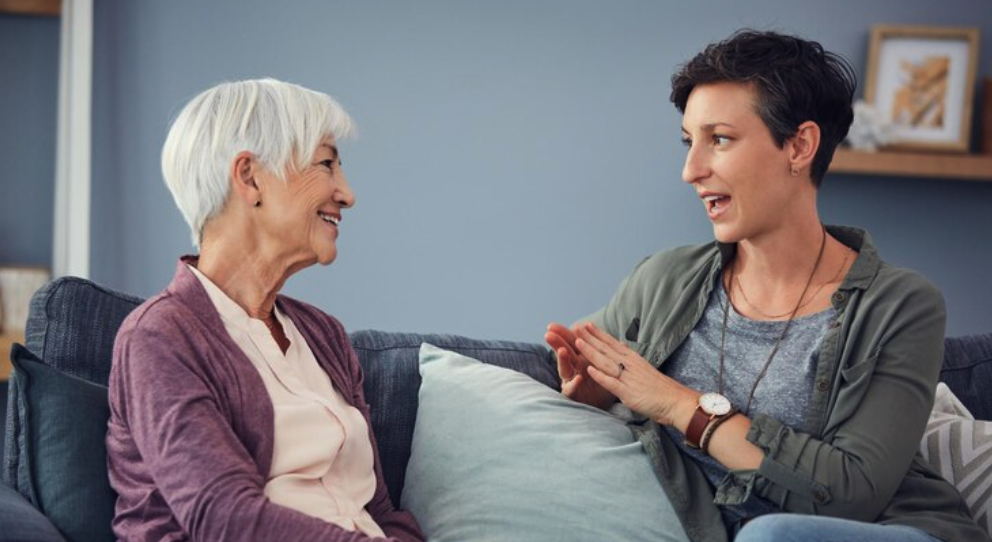General Tips for Communicating with Someone Living with Dementia
Practical guidance to make conversations easier, more respectful, and more effective.
General tips for communicating
- Choose a good place to talk: quiet, well-lit, and free from background noise (TV/radio off).
- Gain their full attention before you start.
- Be at the same eye level — avoid standing over them.
- Sit close without invading personal space.
- Keep your body language open and relaxed.
- Allow enough time and remain calm.
- Prepare key points you want to cover.
- Pick a time of day when communication is easier (e.g., mornings for some people).
- Avoid times when they’re hungry, tired, or in pain.

The way you speak matters
- Speak clearly and calmly, slightly slower than usual.
- Pause between sentences to give time to process and respond — silences are okay.
- Use short, simple sentences.
- Don’t raise your voice or speak sharply.
- Use a conversational style — avoid rapid-fire questions.
- Never speak in a condescending way.
- Be patient and respectful.
- If misunderstandings happen, a shared laugh can ease pressure — but never laugh at the person.
- Always include them in any conversation happening in their presence to support identity and reduce isolation.
What you say is important
- Avoid too many or overly complicated questions.
- Offer choices, but not too many — introduce one idea at a time.
- Ask one question at a time; when possible, use yes/no questions or clear alternatives:
- “Would you like to go for a walk?”
- “Would you like water or orange juice?”
- Break information into smaller chunks.
- If not understood, rephrase rather than repeat.
- Prefer short, regular conversations over long, infrequent ones.
- If they say something you know isn’t true, look for the meaning behind it rather than contradicting:
- e.g., wanting to “pick the children up from school” may reflect a desire to feel useful or involved.
- Consider meaningful, engaging activities to meet that underlying need.

Specific advice for coping with restrictions due to Coronavirus
1. Have a routine
A familiar daily routine builds purpose, reduces anxiety, and makes time indoors easier.
- Agree a simple daily schedule and place it somewhere visible.
- Make a “To-Do” list for long-postponed tasks.
- Keep tasks simple and manageable; focus on one thing at a time.
- Break activities into clear, small steps.
2. Keep active
Even with restrictions, staying active supports independence and wellbeing. Small, regular activity makes a difference.
Be physically active (indoors or outdoors as appropriate):
- Try micro-activities during daily routines: heel raises while the kettle boils, sit-to-stands during TV adverts, bicep curls with tins while waiting for the microwave.
- Encourage involvement in food prep, cooking, and household tasks.
- Dance to favourite music.
- Explore seated activity ideas.
- Go for a walk together if permitted and safe to do so, keeping distance from people outside your household.
- Gardening: weeding, planting seeds, and watching them grow.
Be mentally active — choose activities based on interests and preferences:
- Reading (books, magazines, newspapers) or listening to audiobooks.
- Jigsaws, puzzles, word games.
- Listening to music or favourite radio programmes.
- Watching favourite films or TV shows.
- Using game or creativity apps.
- Knitting or crocheting.
Be socially active — stay connected:
- Brief chats with neighbours from the door, window, or garden (following current guidance).
- Keep in touch by phone, post, text, email, or video call (e.g., Skype, WhatsApp, Zoom).
- Schedule a regular daily check-in time to look forward to.
- Join supportive online communities.

3. Follow good hygiene
Help prevent spread by keeping hands and respiratory hygiene front of mind:
- Wash hands often with soap and water; if unavailable, use hand sanitiser or antibacterial wipes.
- Cough or sneeze into a tissue (or your elbow if no tissue) — never your hands.
- Bin used tissues immediately.
- Avoid touching your face.
